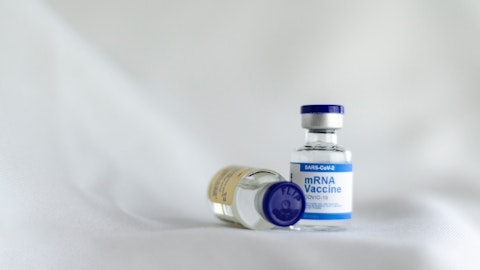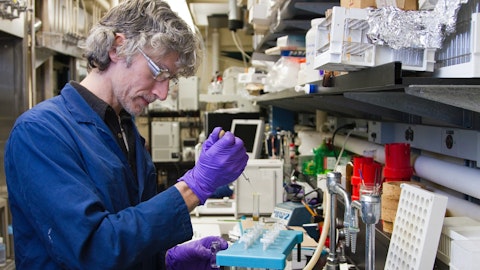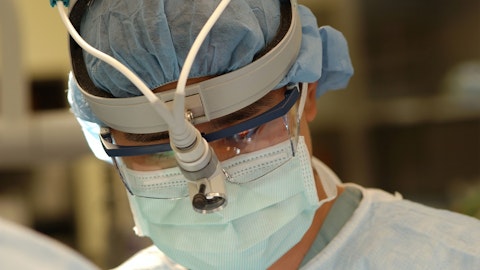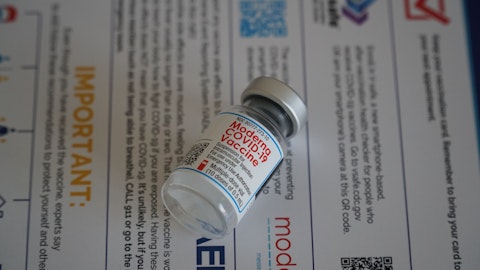Valneva SE (NASDAQ:VALN) Q2 2023 Earnings Call Transcript September 21, 2023
Valneva SE misses on earnings expectations. Reported EPS is $0.26 EPS, expectations were $0.36.
Operator: Good day, and thank you for standing by. Welcome to the Valneva Half Year 2023 Financial Results Call and Webcast. [Operator Instructions] Please note that today’s conference is being recorded. I would now like to turn the conference over to your speaker, Joshua Drumm, VP, Global Investor Relations. Please go ahead, sir.
Joshua Drumm: Thank you, [Vatia]. Hello and thank you for joining us to discuss Valneva’s first half 2023 results and corporate update. It’s my pleasure to welcome you today. In addition to our press release and analyst presentation, you can find our consolidated financial results for the six months ended June 30, 2023, which were published earlier today, available within the Financial Reports section on our Investor website. As always, I’m joined today by Valneva’s CEO, Thomas Lingelbach; and CFO, Peter Buhler, who will provide an overview and update of our business, as well as our key financial results for the first half of the year. There will be an analyst Q&A session at the conclusion of the prepared remarks. Before we begin, I’d like to remind listeners that during this presentation, we’ll be making forward-looking statements, which are subject to certain risks and uncertainties that could cause the actual results to differ materially from those expressed or implied by these forward-looking statements.

Pressmaster/Shutterstock.com
You can find additional information about these risks and uncertainties in our periodic filings with the Securities and Exchange Commission and with the French Market Authority, which are listed on our company website. Please note that today’s presentation includes information provided as of today, September 21, 2023, and Valneva undertakes no obligation to revise or update forward-looking statements except as required by applicable securities laws. With that, it’s my pleasure to introduce Thomas to begin today’s presentation.
Thomas Lingelbach: Thank you so much, Josh. A very good day everyone. Pleasure for me to report our half year one achievements. When we look at R&D, we made substantial progress towards the potential FDA approval of the world’s first chikungunya vaccine. We have online now the Cohort 1 of the Phase 3 VALOR study completing its first tick season, and the Cohort 2 is currently enrolling, and I will provide more details around that. We decided to reinitiate our Zika vaccine development with an expected clinical trial start early next year. Again, I will provide more details around this. When we look at the commercial business, we are very pleased with the commercial performance. Our product sales of almost €70 million have more than doubled as compared to prior year excluding all the COVID sales, of course, and hence we are on track to meet our 2023 sales guidance of €130 million to €150 million.
We had a strong cash position at the end of June with more than €200 million and very recently further strengthened it by an up to $100 million new supplementary debt facility. When we look at the business in detail, let me start with our chikungunya vaccine, which is a live-attenuated vaccine candidate currently under FDA priority review. It is the first chikungunya vaccine candidate in the world that reported positive Phase 3 data with all trial endpoints met. It’s the first chikungunya candidate that has an ongoing BLA application with potential approval and a filing accepted by Health Canada. By way of reminder, our live-attenuated approach was chosen because we wanted to go for a single-shot vaccine that was particularly well suited to target a long-lasting protection compared to other chikungunya assets currently being evaluated in clinical trials.
Our results have demonstrated that our initial development hypothesis holds true and we have excellent data year-to-date on that vaccine, which I’m going to present a bit more in detail. And from a strategic point of view, VLA1553 fits perfectly within Valneva’s existing commercial infrastructure, augmenting our existing travel vaccine portfolio. With regards to target population, geographical reach, you know, that we have on the one hand side the travel business, but also an endemic need, a significant medical need in LMIC countries where we have partnered with CEPI and Instituto Butantan, including certain local manufacturing activities. To remind everyone about the key features and timelines, current FDA PDUFA date end of November, you know, that got extended by one quarter due to ongoing discussions around Phase 4 applications.
We have also the adolescent trial ongoing where we reported positive initial safety, and immunogenicity data will come in November 2023, and we expect additional regulatory processes to commence including the EMA, later this year. Let me turn to Page 7 of the presentation. Since we got many questions about onset of immunity, we would like to present a little bit where we are on our vaccine today. We have data that all got published in different journals, including The Lancet. We have the Phase 3 data, we have also the Phase 1 data, and we have done a number of post-hoc analysis on the back of this data. What we can see here on this Slide is that we have a very nice onset of immunity already at day 15. So, you see, the day 15 data shows data from our Phase 1 cohort and you see that even at a lower dose, which is not the Phase 3 dose and the final dose, we are well, well above the seroresponse threshold already on day 15, which means that in between day eight and day 15, we will surpass the seroresponse threshold, which is identified by PRNT50 greater or equal than 150, and hence, this titer level is reasonably likely to predict protection.
Now, Slide 8 shows you also a little bit where we are on seroresponse and the seroresponse is sustained at highest levels up to month 12. At this point in time, we’re going to readout month 24 in the not-too-distant future. And, what is also important is the graph to the right, where you basically see that there are absolutely comparable titers in younger and older adults. So, basically, we see no difference across the different data points that we have clinically generated, and more importantly, we – also, our vaccine has fast onset of immunity, and I think that’s important to note. It will be further substantiated as part of further studies that we have planned or that are already ongoing. We recently reported positive initial safety results in adolescents and pre-exposed participants.
This study was conducted in partnership with Instituto Butantan. It’s being conducted and funded by CEPI. We had more than 700 adolescents randomized against placebo, and for the first time, we looked at the vaccine in participants with prior exposure to the chikungunya virus Importantly, and this is a very meaningful finding. The vaccine continues to be generally well-tolerated, including in individuals previously infected with chikungunya virus, the AE profile consistent with adults, and the initial data suggest that we see even a more favorable safety profile in seropositive patients or participants, which is in line with what we published in around our Phase 1 data where we basically described our so-called re-vaccination challenge, where people were in parenthesis over-vaccinated with the vaccine itself.
And of course, as we have done for the entire study, the independent DSMB has not identified any safety concerns associated with this vaccine. So, now looking forward, the Phase 4 alignment is, of course, currently the number one topic that we are dealing with. It is the reason for why we got a postponement on the PDUFA date in the first place. We are working very collaboratively with the FDA to align on post-approval Phase 4 requirements. And this is not an easy endeavor for both parties, because this Phase 4 alignment and the design of the Phase 4 activities is likely to set future standards for outbreak disease indications under FDA accelerated approval pathways. Nothing exists today in this regard, and therefore, we are breaking new ground here.
We have additional studies ongoing, antibody persistence study. You know that we are following the cohort here for five years because we want to show that after a single shot that there is long protection. We reported the 12-month data in December and the 24-month data, I expect it logically by the end of this year. Adolescents Phase 3 trial, I mentioned already that this trial is important to support potential label expansion, and licensure in Brazil is funded by CEPI, and also an important part of the data needs to be included and will be included in the EMA submission. With regards to anticipated future trials, we are planning for co-vaccination pediatric and special populations. And then of course, execution on the Phase 4 program and Phase 4 effectiveness in endemic setting.
So, when we look at the market, Page 11 of the presentation, I mentioned it briefly, we have the travelers from non-endemic regions, highly complementary with our existing travel portfolio, significant need as we see more and more outbreaks including Europe and the Americas. We see a military opportunity here as well for troops stationed in areas with risk of chikungunya, and of course, in areas where we need to prepare for potential outbreaks or get already responses during outbreak situations. We are working, as mentioned before, with CEPI and Instituto Butantan. I’m very happy with this collaboration overall. So, in a nutshell, we continue to be absolutely excited about this first chikungunya vaccine that hopefully is going to make it to market and we are looking forward to our PDUFA date and the approval of this vaccine in the United States first, and then in other countries thereafter.
Yes. When we look at our Lyme disease program, our program VLA15 is the only Lyme disease program in advanced clinical development today. We had multiple, you know, Phase 2 studies, as you know, including first pediatric and adolescent data. We have currently the Phase 3 ongoing called study VALOR, and we have partnered here with Pfizer, and this partnership with Pfizer is a very fruitful and very constructive partnership that has continued now for a number of years, and we have disclosed at multiple occasions the terms under which this exclusive worldwide partnership with Pfizer operates. By way of reminder, with regards to this vaccine, it’s a recombinant protein vaccine candidate, multivalent targeting the six most prevalent serotypes causing Lyme disease in the United States and Europe, because we wanted to make sure that we have a vaccine for people living and going to both sides of the Atlantic.
It is targeting the outer surface protein A of Lyme borreliosis, and hence follows an established mechanism of action for a Lyme disease vaccine, and therefore, has also a high degree of derisking associated with that effect. The program operates under Fast Track Designation granted by the U.S. FDA in July 2017. As mentioned before, we have demonstrated strong immunogenicity results across three different Phase 2 studies, which included also pediatric data Overall, we see very strong data here, and I think that’s something, especially the strong anamnestic response and strong booster response for a vaccine that might need a booster either annually or at a longer cadence, remains a very important result and this is another key step towards a potential vaccine solution in this field of high, high unmet medical need.
On the Phase 3 efficacy study itself, we are receiving many questions around the study, so therefore, let me repeat again the key cornerstones of this study. Around 9,000 participants, greater five years of age, so literally we cover the vast majority of the target population and we are including people at high risk of Lyme disease by residence and/or occupational or recreational activities. In the U.S., in Canada, and in Europe, we are randomizing 1:1 against placebo, and 2:1 U.S. versus non- U.S. With regards to the primary endpoint, primary endpoint is the rate of confirmed Lyme disease cases after two consecutive tick seasons, meaning, after completion of the full primary season, sorry, meaning three doses plus the booster dose, and as part of the secondary endpoints, we of course look at the efficacy after priming with three doses amongst other secondary endpoints as defined in the Phase 3 protocol.
Following the discontinuation last year for one part of the study, one cohort of the study that was run through a specific set of study centers, we have now split into two cohorts still under the roof of one study. You see the enrolled participants cohort, one in blue. Here you see the three doses month – given at month zero, two, and six, and the booster in after 18 months. So, basically, this cohort has been completely enrolled. We are now completing the tick season 2023, and will be given the booster shot next year, and the core tool is rolling and you see zero to six, and then the booster in tick season 2025. Pfizer aims to submit the regulatory applications in the U.S. and Europe in 2026 subject to positive data, which we hope to see at the end of 2025, after the completion of the 2025 tick season.
Then if we turn over to Zika, you know that Valneva has a Zika vaccine in it’s R&D portfolio for a number of years. We paused the development program when we re-focused our resources towards the COVID vaccine development. Now that the COVID development or COVID vaccine development is behind us, we have re-activated our Zika program because we believe that there is a significant unmet medical need. And basically, what we see here is also a highly complementary potential asset when it comes to leveraging our existing inactivated whole-virus platform that we initially developed for Japanese encephalitis, and then further enhanced and modified for our COVID vaccine, VLA2001, so it can be a very nice plug and play onto our existing platforms. At the same time, this is a vaccine candidate that would also fall under an accelerated approval pathway for which we are now, with the help of our CHIK development, generating a lot of expertise and capabilities.
So, that’s the reason number two. Reason number three is actually that we meet the desire to Target Product Profile as articulated by WHO. All of that led us to our decision to continue or restart with our Zika development with a trial start as early as probably next year. Yes. When you look at our portfolio, we are working on a number of things in the preclinical arena. I would like to point out hMPV for which we completed our preclinical proof of concept successfully, given that the vaccine development environment is transitioning towards an RSV hMPV combination vaccine. We have initiated partnering discussions and those discussions are currently underway, and partnering is under evaluation. Our lead candidate in the preclinical arena remains EBV, Epstein-Barr virus.
We are currently in the final antigen identification phase and hope to have a final product candidate designed by the end of this year. Of course, we are working on a number of other things in the pre-clinical shop, but we are giving of course priority and focus and I would like to remind you that our overall R&D portfolio management always strives towards delivering highly differentiated assets, first-in-class, best-in-class, only-in-class. And with that, I would like to hand over to Peter to provide us the financial report and take us through the rest of the presentation. Thank you.
Peter Buhler: Thank you, Thomas, and good morning and good afternoon to all of you. Now, let’s look at the financial review of the first half of fiscal year 2023. Product sales reached €69.7 million and grew 109% over prior year. At constant currency, product sales grew 113.6%. The strong growth is driven by all product lines, with IXIARO growing at 150% at constant currency, DUKORAL at 213%, and third-party products at 46.8%. This excellent sales performance is primarily driven by the recovery of the private travel market, but also by price increases across the board. In the first half year, we also still recorded residual COVID-19 vaccine sales related to a pre-existing contract with the Kingdom of Bahrain. Moving on to the income statement.
Total revenues reached €73.7 million versus €93.2 million in the first half year of 2022, a decrease of 20.9%. In the prior year, Valneva had recognized other revenues related to its COVID program, which explains this decrease. Looking at expense, we observed a significant decrease in cost of goods and services from €171.5 million in the first half of 2022 to €53.8 million in the current fiscal half year – first half year. Prior year’s cost of goods and services were heavily impacted by one-off items related to the wind-down of our COVID-19 program. The gross margin of both IXIARO and DUKORAL is still below pre-COVID levels and is amongst others, adversely impacted by IXIARO batch write-offs in our Scottish manufacturing site and high sales volumes in indirect markets, where our average selling price is lower than in direct markets.
In the first half year, we also recognized initial cost of goods related to the launch preparation of our chikungunya vaccine candidate. Research and development expense decreased from €51.9 million in 2022 to €26 million in the first half year of fiscal year 2023. That decrease is again driven by the lower spend on Valneva COVID vaccine programs and at the same time, the cost related to the Zika vaccine candidate increased as the company has been working towards a re-initiation of our clinical development program. Marketing and distribution expense increased significantly year-over-year from €7.8 million to €20 million. The increase is related to higher pre-launch costs for our chikungunya vaccine candidate that more than tripled versus prior year.
In addition, high EC spend has had a positive impact related to our share – employee share-based compensation. G&A expense increased from €60 million in 2022 to – 2020 – to €22.9 million in 2023. In the prior year, all expense lines had a favorable effect for a total of €19.5 million related to employee share-based compensation due to the share price development. The increase in other income from €3.6 million to €14 million is mainly related to the recognition of a grant received from Scottish Enterprise. Overall, the company recorded an operating loss of negative €35 million versus €150.4 million in the prior year. Adjusted EBITDA improved from €136 million to €28 million negative. Finally, we reported a cash and cash equivalent at June 30, 2023, of €204.4 million compared to €289.4 million at the end of December 2022.
This position, as mentioned, does not include the increased debt facility of $100 million of which $50 million were drawn down in the third quarter of 2023. Now moving to Slide 21, to review our guidance for the fiscal year. We reiterate our guidance for revenues and other income communicated earlier this year. We expect product sales to reach between €130 million and €150 million, and other income to reach €90 million to €110 million. We also reiterate our guidance on R&D investment expected between €70 million and €90 million. This concludes the finance section of this call. And now let’s move to Slide 23, looking at upcoming catalysts and news flow. On our VLA1553 program, we still anticipate the PDUFA action date and the potential BLA approval at the end of November.
We also expect to release adolescent immunogenicity results in November 2023, and progress towards and submit actually EMA regulatory submission in Q4. Also in Q4, we’ll report additional 24-month antibody persistence data and we expect the ACIP recommendation for Q1 in 2024. On VLA15, we expect the trial execution to continue with the recruitment of the Cohort 2 in advance of the 2024 tick season as explained by Thomas earlier during this call. Additional news flow, we expect imminently to announce a new DoD contract for IXIARO and then potential granting of FDA priority review voucher as we obtain the VLA1553 BLA approval. Also as already mentioned, we expect initiation of our Phase 1 clinical trial of Zika in our – in the first quarter of 2024, and the advancement of selected preclinical programs mentioned just before, by Thomas.
With this, we really see Valneva poised for substantial growth, primarily led by new product launches. We see in the next six to 12 months, of course, VLA1553 reaching the market, and then longer-term, VLA15 reaching the market and for Valneva to actually be able to record significant milestones in revenue – at milestone revenues. Additional growth drivers, of course, the continuous recovery of the travel market that will be reflected in substantial growth still in IXIARO and DUKORAL. As mentioned, the DoD contract for IXIARO, and then potential label expansion for 15 – VLA1553 after the initial approval in adults. And then of course, longer-term, in-licensing or acquisition of additional clinical candidates, and then potential market launch, of course, of these in-licensed programs.
So, this concludes this part of the call. I would now like to hand back to Vatia to open the Q&A session.
See also 12 Best Low Cost ETFs and 20 Easiest Jobs That Pay $100K.
Q&A Session
Follow Valneva Se
Follow Valneva Se
Operator: [Operator Instructions] We are now going to proceed with our first question. And the questions come from the line of Maury Raycroft from Jefferies. Please ask your question.
Maury Raycroft: Hi. Thanks for taking my questions. I was going to ask one on chikungunya. What are your latest thoughts on what a potential Phase 4 outbreak study might look like in terms of size, geographic areas, or any other details? And I’m also wondering, is the outbreak study something that ACIP could potentially want to see for a recommendation or how do you view that study in the context of ACIP?
Thomas Lingelbach: Hi, Maury. You, of course, will understand that given that we are in the middle of agreeing and aligning the Phase 4 activities with the FDA, there is only very little I can say in public around that. What I can say so, it is under the accelerated approval pathway. We need to show effectiveness in a real-life setting, meaning in endemic countries, and ideally during an outbreak situation. And so, therefore, you need to get prepared for that, and you need to have also different populations included, meaning adolescents, as well as adults. Now, the – historically, ACIP have not been awaiting for – or awaiting final effectiveness data which sometime take many, many years to provide their vaccine recommendations, and at this point in time, we do not expect this to happen.
So, we have a strong database that we’re going to present, have presented, and will continue to present to ACIP, and that’s basically a strong package. More I can at this point in time unfortunately not say, but soon we will, of course, be in a position to explain what we’re going to do and then, I hope for your patience until then.
Maury Raycroft: Okay. Yes, makes sense. And I was going to ask one other question about chikungunya. You’ve talked about the different revenue streams, including travel sales in the U.S. and EU, military and potentially – and potential stockpiling contracts, and then endemic. Can you talk about the potential cadence of the launch in terms of these different revenue streams? How are you preparing currently for the launch? And have you thought of when you might give guidance on sales for some of these groups post-launch?
Thomas Lingelbach: Yes. That’s an excellent question, Maury. So, first of all, I mean, as you know, we have been prioritizing the travel, and let’s say, outbreak preparedness in the highly developed countries, so meaning, we started with the U.S. where we see by far the single largest market opportunity in terms of revenue, then followed by Canada and EMA. So, this is the cadence. So, you know that the Canadian filing got accepted. We disclosed that. Next step is, of course, EMA. And then we will go immediately into Brazil. And we are currently looking also into the next most important LMIC territory, which of course is Asia. So, this is probably the cadence of how we’re going to approach it from a regulatory and licensure perspective.
With regards to outbreak preparedness stockpiling, I mean, there’s not a dedicated regulatory process needed for that in the highly developed countries. Having said that, we have a quite significant number of initiatives ongoing to potentially attract a stockpiling business. That this is the part where we felt thus far not very comfortable providing any guidance on how big this opportunity might or might not be, but there is a lot going on and we hope that we will also attract some business in this segment too.
Maury Raycroft: Got it. All right. Thanks for taking my questions.
Operator: We are now going to proceed with our next question. And the questions come from the line of Samir Devani from Rx Securities. Please ask your question.
Samir Devani: Yes. Hi guys. Thanks for taking my questions. Just a couple really on the numbers. Is this the last of the COVID-19 vaccine orders that we’re expecting? And on R&D, can you just maybe explain what would make you come in at the bottom or at the top end of your guidance? Thanks very much.
Thomas Lingelbach: So on – yes, thanks, Samir, for the questions. So, on COVID-19, there is one – there is some small residual revenue expected still in the second half of the year. But we’re mostly done with COVID-19 in terms of revenues. In terms of R&D, yes, great question. And I guess, your question really targets towards the level of spend we see for the first half year compared to the guidance. Obviously, yes, so we do – we – we are tracking to more towards the lower end of the guidance when you look at the first half year of course. And that is – so where we land ultimately is I think to a large extent, of course, driven by you know how much do we still spend on the ongoing trials, in particular on chikungunya, but then also of course, you know, how quickly do we accelerate spend on Zika. So, that’s really the key drivers on the R&D spend.
Peter Buhler: Yes. And in addition to that, Samir, it’s also related to when we’re actually going to initiate some of the additional studies for chik. You have seen that we have quite a number of studies planned for chikungunya. Of course, we will and can only start some of the studies once we have gotten the approval of the vaccine. So, that’s why there is a – there is a couple of swing factors in there, which all – which may affect the final spend, especially with regards to R&D expenses, which we call the direct R&D expenses, meaning external R&D costs with CROs, et cetera, in the fourth quarter of this year.
Samir Devani: Great. Thanks very much.
Operator: We are now going to proceed with our next question. And the questions come from the line of Simon Scholes from First Berlin. Please ask your question.
Simon Scholes: Yes, hello. Thanks for taking my questions. I’ve got two. First of all, I was wondering, on the commercial vaccine business, if you could tell us how much direct sales was in Q2. I think the figure for Q1 was 71.6%. And I was also wondering if you could quantify the batch write-off on IXIARO in Q2. Thanks.
Thomas Lingelbach: Yes. Thanks. Let’s start with the second question on batch write-off whilst we are looking for the number on direct sales. So, you will understand that this is something we are not publishing. I mean, we did have – the reason why we mentioned it is because it was a higher amount than what we usually see, which is really related to the fact that we are basically restarting full steam commercial manufacturing post-COVID. But again, we’re not disclosing the actual write-off. In terms of the proportion of direct sales, I need to just look at this. So it was 65% in Q2.
Simon Scholes: Okay. And would you expect the number to stay around that level –
Thomas Lingelbach: No, clearly not. I think this was unusually high in both Q1 and Q2, and we would expect for the remainder of the year to get more towards ratios like we saw in the past.
Peter Buhler: Especially by military kicking in, remember that. Yes.
Simon Scholes: Okay. Yes. Okay. Thanks very much.
Operator: We are now going to proceed with our next question. And the questions come from the line of Damien Choplain from Oddo BHF. Please ask your question. Hello, Damien, can you – your line is open, please ask your question. The next questions come from the line of Damien Choplain from Oddo BHF. Please ask your question.
Damien Choplain: Yes, hello. Can you hear me?



